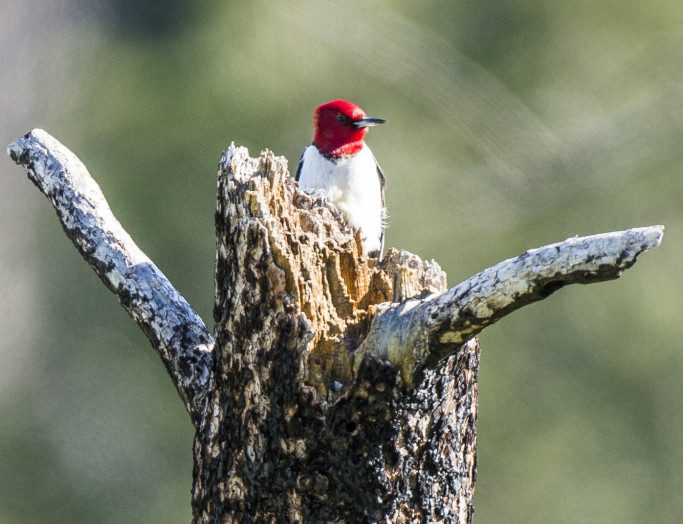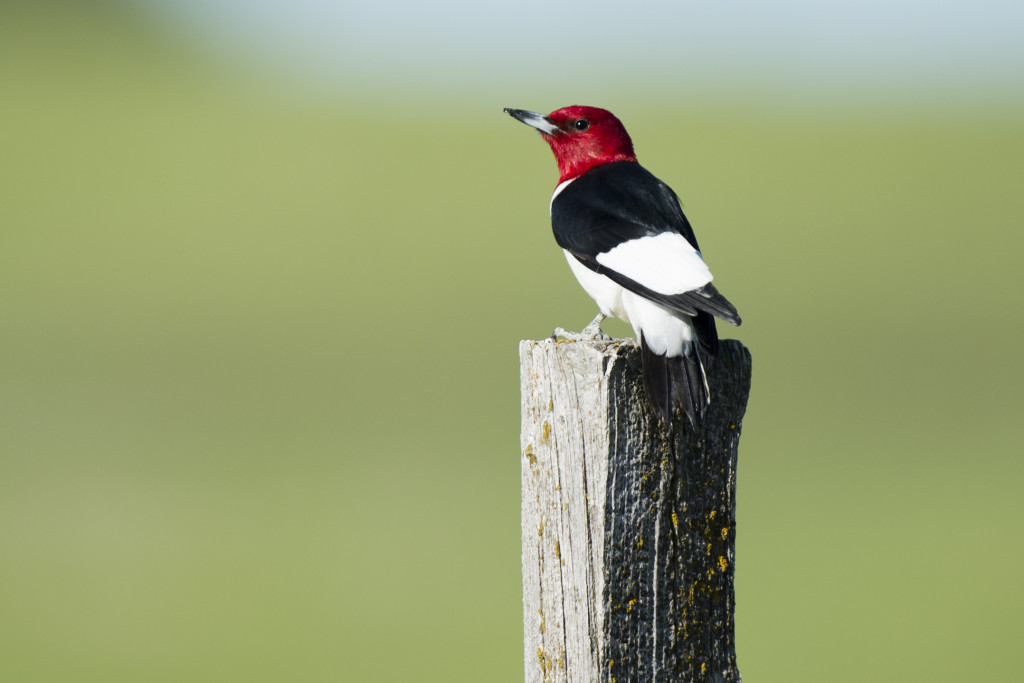
By Justin Haag
Aerial proficiency to swoop and snatch prey from the sky. Symmetrically arranged talons for clinging to vertical surfaces and a chiseled beak that hammers hardwood surfaces at 1,000 times the force of gravity. A long barbed tongue, three times as long as that self-sharpening dagger-like bill, for retrieving victims from deep within a crevice. All that, and a fiery red head.
If readers were to consider that description alone, they might assume it applies to a mythical monster dreamed up by a Hollywood scriptwriter. Instead, it is an illustration of the red-headed woodpecker (Melanerpes erythrocephalus), the handsome bird affectionately referred to as the “flying checkerboard” that can be found throughout Nebraska.
With its stunning red, white and black appearance, the red-headed woodpecker has aptly assumed the role of a “spark bird” for many birdwatchers. That is, a species that sparks a person’s interest in nature. After all, the bird has a range throughout the continental United States east of the Rocky Mountains, and the bright plumage on its 9-inch body can often draw attention from vehicles as it clings to the sides of power poles and fence posts.

Similar to all woodpeckers, redheads are attracted to “snags,” the dead still-standing trees that not only provide potential for digging a nesting cavity, but also house nutritious insects on and beneath the wood’s surface and provide perches.
With fossils of the red-headed woodpecker dating back 2 million years, the species has survived many challenges. The overall population of red-headed woodpeckers has sharply declined in recent years because of habitat loss and changes to the birds’ food supply, however. A number of
human-related actions have been harmful to populations, and the Cornell Lab of Ornithology reports the species has faced a cumulative decline of 70 percent since 1966. It has occasionally been placed on conservation watch lists and given “near threatened” status.
Regardless, unlike many other regions of North America, data shows the species is doing well in Nebraska, especially the western part of the state.
In nature’s kingdom, one species’ struggle can serve as another one’s boon. Maladies that kill off trees, such as Dutch elm disease and chestnut blight, have helped woodpecker populations thrive in those areas. After large catastrophic wildfires in the Pine Ridge of northwestern Nebraska, the most recent of which was 2012, red-headed woodpeckers have become a familiar sight among the blackened snags that remain – much like the proverbial blooming rose in a bed of sand.
Joel Jorgensen, nongame bird program manager for the Nebraska Game and Parks Commission, said red-headed woodpeckers are drawn to such places and fires have the potential to increase local populations, depending on the severity. Research shows that fires not only create more snags, but also can create more open forest stands for flycatching. As long as fires do not destroy active nest cavities, they can be beneficial.
“Dense woodlands are less desirable and host lower densities of birds,” Jorgensen said. “So, a good fire can produce a lot of primo red-headed woodpecker habitat, but if it burns everything and there are no snags, there may be little or no habitat left.”
Chaley Jensen of Scottsbluff, Nebraska’s education coordinator for the Bird Conservancy of the Rockies, said no red-headed woodpeckers were captured in nets in the first seven years of the conservancy’s banding station at Chadron State Park. However, one was caught two years after fire burned through the park, and the station has captured and banded seven others since. Perhaps the captures were just coincidence, but those birds surely have used the burned trees of the area.
With an increasing number of trees from the 2012 fires decaying and falling to the ground, any boom brought by that event may be on the downward slide. Regardless, there is still a lot of forest remaining in the Pine Ridge, and undoubtedly more wildfires to come – although land managers are working to make them much less severe. Research shows that prescribed burning can also have positive effects for woodpeckers and many other species.
Adult males and females, which both help rear their young, have the same conspicuous appearance, but chicks have gray-brown plumage that serves as camouflage as they stick their heads from the holes in dead trees waiting for parents to deliver food.
While primarily insectivores, the redheads are the most omnivorous of woodpeckers, with a diet that changes throughout the year. It is one of four woodpeckers known to store food and the only one known to cover stored food with wood or bark. It often packs insects in crevices, sometimes alive, to be eaten later.
Limiting use of insecticides and leaving dead trees standing are among the best ways to help the species. As with other woodpeckers, suet is the best attractant for feeding stations. Nut-bearing trees attract them in winter, but most Nebraskans are not apt to see the species then.

The red-headed woodpecker’s breeding range extends throughout Nebraska, but only the southeastern corner of the state is identified as wintering range. Jorgensen said Indian Cave State Park in the state’s southeastern corner provides birdwatchers the best bet for seeing one on public land in colder months, but “abundance that time of year is variable and linked to the supply of acorns.”
Many cavity-nesting birds and mammals that do not create their own holes benefit from past work of the woodpeckers. As with many of those cavity-nesters, nonnative European starlings have been detrimental to populations of red-headed woodpeckers by stealing nest sites.
Yet, in addition to insects, there are members of the woodland community who surely see the red-headed woodpecker not for its beauty, but rather as a feared menace. They are ferocious defenders of their territory and have a reputation for terrorizing nests of other birds within it, going as far as puncturing or ejecting eggs.
In early colonial America, when small cornfields and orchards were interspersed among woodlands, the woodpecker was viewed as an agricultural pest and a two-pence bounty was paid for each red head. With today’s large fields and monoculture, damages are considered much less and the bird has a more positive reputation.
The “flying checkerboard” may have a checkered history and tough demeanor, but most surely agree that these birds have a way of brightening our landscapes and certainly bring a splash of color to roadsides and dead trees.
